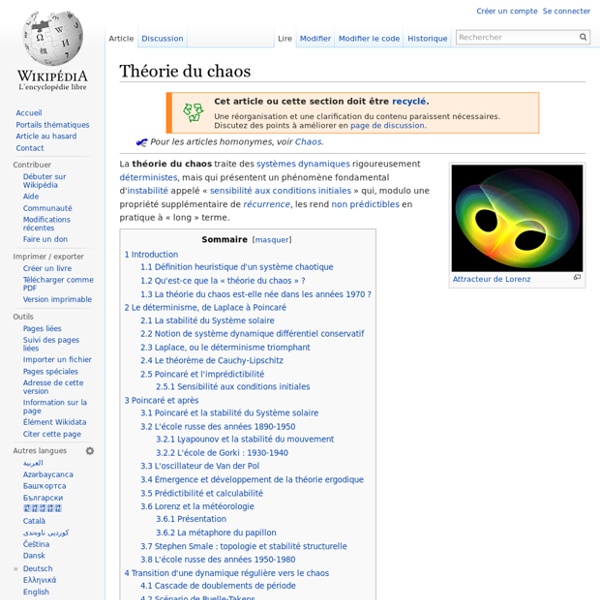



http://fr.wikipedia.org/wiki/Th%C3%A9orie_du_chaos
Order Out of Chaos" Let's return to the world of weather forecasts for a moment, as well as the world of butterflies and hurricanes. You've probably heard of chaos theory, the mathematical field concerned with the seemingly disorganized behavior of highly dynamic systems. The term originates in 1961 with meteorologist Edward N. Lorenz and his fascination with how the smallest of atmospheric variables can result in drastically different weather models. the_dimka: codex seraphinianus in the late 70s italian architect, illustrator and industrial designer luigi serafini made a book, an encyclopedia of unknown, parallel world. it’s about 360-380 pages. it is written in an unknown language, using an unknown alphabet. it took him 30 month to complete that masterpiece that many might call “the strangest book on earth”. codex seraphinianus is divided to 11 chapters and two parts - first one is about nature and the second one is about people.btw five hundred years ago there was another book somewhat like that - voynich manuscript. take a look at some pages (click on image to see a bigger version) amazon sells those for 500 bucks or more
Fractal Adaptive Cycles in Natural and Human Syst The bewildering, entrancing, unpredictable nature of nature and people, the richness, diversity and changeability of life come from that evolutionary dance generated by cycles of growth, collapse, reorganization, renewal and re-establishment. We call that the adaptive cycle.Holling, 2009 Figure 1: Sierpinski Triangle Fractal Holling, Panarchy and Resilience Arguably the most significant thinker in the field of ecological cycles has been Buzz Holling, who refers to the conceptual model he derived from the study of forest ecosystems as Panarchy.
John Holland, Emergence The Bactra Review: Occasional and eclectic book reviews by Cosma Shalizi From Chaos to Order John Holland John Holland - Emergence: From Chaos to Order Reviewed byTony Curzon Price, W3, ESRC Centre for Economic Learning and Social Evolution, University College London. Here is one of my favourite illustrations of emergence: ... consider one particular copper atom at the tip of the nose of the statue of Sir Winston Churchill that stands in Parliament Square in London. Let me try to explain why that copper atom is there. It is because Churchill served as Prime Minister in the House of Commons nearby; and because his ideas and leadership contributed to the Allied victory in the Second World War; and because it is customary to honour such people by putting up statues of them; and because bronze is the traditional material for such statues, and so on. Thus we explain a low-level physical observation - the presence of a copper atom at a particular location - through extremely high level theories about emergent phenomena such as ideas, leadership, war and tradition.
The Spirit of the Internet - Chapter 4 Technological Singularity "The universe may not only be stranger than we suppose; it may be stranger than we can suppose." J.B.S. Haldane The Four Chaos Attractors - Fractal Wisdom The Science of Chaos has discovered four basic Cosmos Attractors: Point Attractor | Cycle Attractor | Torus Attractor | Strange Attractor Although known as the four "chaos attractors," they are really the opposite - they are Cosmos Attractors that balance chaos. The four "Attractors" bring order out of Chaos. They are part of a basic law of four - a "fractal of four."
Order out of Chaos Where you place your emphasis determines in large measure the quality and impact of your life. Consider this for a moment. Every situation that comes your way will contain a mixture of orderly and chaotic elements. Fear or react to the chaos and you will tend to perpetuate the chaos, if not add to it.